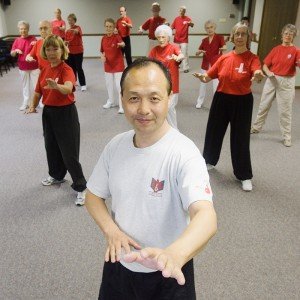Practice Gong (功), Not Only Quan (拳)
by Yang Yang, Ph.D.
 The Rabbit is here. In China, the holiday season is the time to be grateful to all of our teachers. This gratitude and a comment from a workshop participant at a recent workshop prompted me to share a story with you.
The Rabbit is here. In China, the holiday season is the time to be grateful to all of our teachers. This gratitude and a comment from a workshop participant at a recent workshop prompted me to share a story with you.
I went to Kripalu Yoga Center the day after Thanksgiving and had a wonderful workshop with an intellectual, open, and fun group. Toward the end of the workshop, a participant asked me, “Where is the Taiji routine I was supposed to learn in this workshop?” I told her that I did not teach the group any routine. Instead, I taught the foundation for doing any type of Taiji or Qigong, as well as movement in daily activities. We spent the whole weekend on standing, sitting, and lying-down meditations (static, and dynamic). These fundamental training methods work effectively on our gong: our energy, posture alignment, agility, flexibility, power, autonomic nervous system, immune function, sleep, tranquility of our minds, positive outlook, and other essential components of our wellbeing. Then I went further, telling the group the following story:
In the summer of 1983, a year after I’d met Grandmaster Feng in Shanghai, I went to Beijing to study with him and further my training. One day I asked him how important it was to learn forms and techniques to improve my pushhands. He did not answer this question directly, instead, he pointed to his two year old grandson. “I am crazy about this boy and I would teach him all the martial arts forms and techniques I know. But you could send him flying without much technique or form training. Does that make sense?” I nodded my head and understood his message. It is the gong, no matter the number of forms and techniques you learn, that counts in pushhands and the rest of taiji.
Forms and techniques are significantly more efficient at building martial arts skill and nourishing health when they’re practiced in conjunction with static and dynamic qigong practice. We are all busy; we are all trying to make our practice as effective as possible, and we are all wanting to walk a straight path. I am passionate about telling the grandson-story whenever I see people mistakenly equating taiji practice to form, qinna (joint locking) or push-hand techniques. If they would add qigong meditation to their practice, they would profit far more from the time they invest in their practice.
 [Dr. Yang Yang was born in 1960s in Henan province near the Chen Village in China. At the age of 12, he began studying Taiji because of a congenital heart defect. He credits his practice of Chen Style Taiji with curing his heart condition and allowing him to pass the physical exam required in China to enter the universities. Master Yang’s Taiji studies now span 30 years. With both Law and Engineering degrees earned in China, Master Yang practiced business law for several years before coming to the United States to study for a Master’s Degree in Economics at Illinois State University. He is currently the Director of the Center for Taiji Studies in Champaign, Illinois, and earned his Doctorate Degree in Kinesiology at the University of Illinois. His research focuses on the benefits and mechanisms of Taiji practice.]
[Dr. Yang Yang was born in 1960s in Henan province near the Chen Village in China. At the age of 12, he began studying Taiji because of a congenital heart defect. He credits his practice of Chen Style Taiji with curing his heart condition and allowing him to pass the physical exam required in China to enter the universities. Master Yang’s Taiji studies now span 30 years. With both Law and Engineering degrees earned in China, Master Yang practiced business law for several years before coming to the United States to study for a Master’s Degree in Economics at Illinois State University. He is currently the Director of the Center for Taiji Studies in Champaign, Illinois, and earned his Doctorate Degree in Kinesiology at the University of Illinois. His research focuses on the benefits and mechanisms of Taiji practice.]
